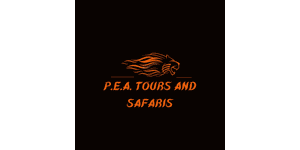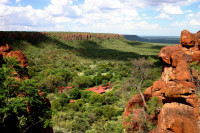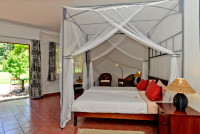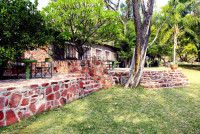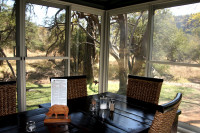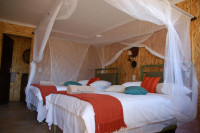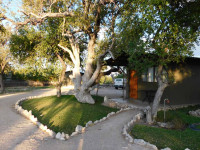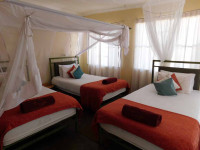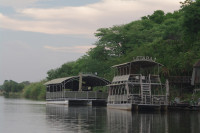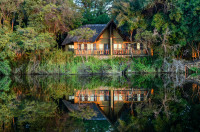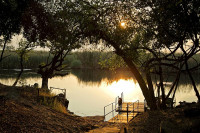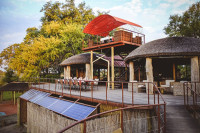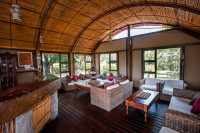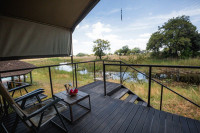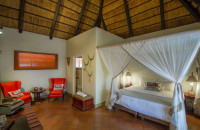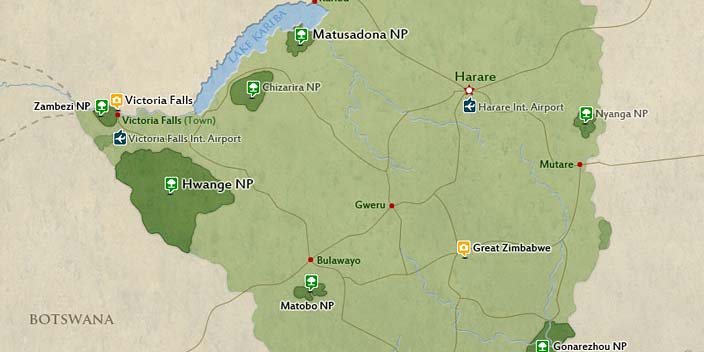
$6,160 pp (USD)
2 travelers on Start dateArrival
Arrival

Day 1
Waterberg Plateau Park
Waterberg Plateau Park
You will meet your guide either in Windhoek or the airport and drive to your first destination, the Waterberg Plateau Park. Rising as an island of color some 200 meters above surrounding African bush and savannah, this 405 km2 park was reserved for endangered and protected species in 1972. It is home to some 25 game and over 200 bird species. Rare species such as roan and sable antelope, Cape buffalo, and Tsessebe occur in large numbers. Black and white rhinos are also firmly established on the plateau.
This afternoon, you will do a game drive and a sundowner as a welcome to your adventure tour.
- Main Destination:
- Waterberg Plateau Park (Namibia)
- Accommodation:
- Waterberg Wilderness Lodge
- Meals & Drinks:

Day 2
Bushmanland
Bushmanland
After breakfast, you will head northwards past a couple of privately owned farms, to Bushmanland's main town, Tsumkwe. Before your lunch stop, you will visit the world's heaviest metallic meteorite, the Hoba Meteorite. This 60-ton meteorite is mostly comprised of iron and nickel, with traces of cobalt. After lunch, you will make your way more eastwards to Tsumkwe. We have time to feel the tranquility of the lodge area before dinner.
- Main Destination:
- Khaudum National Park (Namibia)
- Accommodation:
- Tsumkwe Country Lodge
- Meals & Drinks:

Day 3
Bushmanland
Bushmanland
This morning, you will visit the San (locally known as the Bushmen) people with a local guide. The San population has been living in the vast Kalahari Desert region for over 20,000 years. You will experience bush walks with San trackers, who will demonstrate hunting, snaring, and tracking skills, food gathering, and sharing their knowledge of local customs and beliefs. After lunch, you will explore the southern part of Khaudum National Park.
- Main Destination:
- Khaudum National Park (Namibia)
- Accommodation:
- Tsumkwe Country Lodge
- Meals & Drinks:

Day 4
Khaudum National Park
Khaudum National Park
After an early morning breakfast, you will enter the southern gate of Khaudum National Park and drive the whole day through the park to the northern side. This is a 3 842 km2 densely wooded wilderness reserve and the only conservation area in Namibia where the northern Kalahari sandveld biome is protected. Game numbers vary considerably, as the park is unfenced thus enabling the animals to follow their natural migration routes. Khaudum is the stronghold of Namibia’s Roan Antelope. Other mammals include blue wildebeest, oryx, eland, reedbuck, elephant, giraffe, lion, leopard, spotted hyena, and side-stripped and black-backed jackals among others. About 320 bird species have been recorded and special ones include coppery-tailed and Senegal coucal, Bradfield’s hornbill, Rufous-bellied tit, black-faced babbler, and sharp-tailed starling. This is the only day of the trip, you'll experience wild camping at Khaudum Campsite. You may help your guide cook on an open fire and set up your tent.
- Main Destination:
- Khaudum National Park (Namibia)
- Accommodation:
- Budget camping
- Meals & Drinks:

Day 5
Bwabwata National Park (Mahango Core Area)
Bwabwata National Park (Mahango Core Area)
After enjoying your breakfast cooked on an open fire, you will exit the park and drive more east to the wetlands. The Bwabwata National Park is 6100 km2 and includes the Mahango, Buffalo, and Kwando (Golden Triangle) Core Areas. It forms part of the KAZA (Kavango Zambezi) Transfrontier Conservation Area which is the world's largest conservation area that incorporates joint management from 5 countries: Namibia, Botswana, Angola, Zimbabwe, and Zambia. This is a new generation of parks in terms of an integrated approach to park management. The part of the park is zoned for community-based tourism including human settlement and development. Mammals include elephant, buffalo, common impala, reedbuck, red Lechwe, Sitatunga, hippopotamus, giraffe, plains zebra, Tsessebe, Sable antelope, roan antelope, Chobe bushbuck, red hartebeest, lion, leopard, cheetah, African wild dog among others. You should be in time for an afternoon game drive in the Mahangu Core Area.
- Main Destination:
- Mahango Game Reserve (Zambezi Region, Namibia)
- Accommodation:
- Mahangu Safari Lodge
- Meals & Drinks:

Day 6
Bwabwata National Park (Mahango Core Area)
Bwabwata National Park (Mahango Core Area)
You'll have the whole day of game drive, with a lunch/siesta/swimming pool break in between. You will do a morning game drive in the Buffalo Core Area and an afternoon game drive in the Mahango Core Area. In Buffalo Core Area several game species do seasonal movements. They remain at the Okavango River during the dry season and move inland during the wet season which is an important natural mechanism that guarantees that the vegetation structure can be in a resting period. A part of the Buffalo Core Area is situated in the ruins of an old South African army station and ironically, there is lots of game around this part of the park. The Mahango Core Area is located on the west side of the Okavango River. The park is very small and has a size of only 245 km². Because of the lack of surface water, wildlife is mainly found along the Okavango River (Kavango River as Kavango people prefer calling it on the Namibia side), and this is where you will spend more time.
- Main Destination:
- Mahango Game Reserve (Zambezi Region, Namibia)
- Accommodation:
- Mahangu Safari Lodge
- Meals & Drinks:

Day 7
Bwabwata National Park (Kwando Core Area)
Bwabwata National Park (Kwando Core Area)
This morning before you leave for a 3-hour drive to Kwando Core Area, you will do a morning Boat Cruise on the Okavango River. Besides mammals, the birding is excellent in this area as it is also recognized internationally as an Important Bird Area to support bird species that are endangered or threatened. Some of the highlight species include the Wattled Crane, African Pygmy Goose, Coppery-tailed Coucal, Southern Ground Hornbill, Bennett’s Woodpecker, Wood Owl, White-backed Night Heron, African Skimmer, Brown Firefinch and rare vagrants like the Northern Carmine Bee-eater have been recorded recently. After enjoying your lunch packs at a picnic site, you will explore the Kwando Core Area before settling for the night at the lodge. The Kwando River system is different from the Okavango in that comprises a network of oxbows, some of which are several kilometers away from the river's current course.
- Main Destination:
- Bwabwata National Park (Zambezi Region, Namibia)
- Accommodation:
- Namushasha River Lodge
- Meals & Drinks:

Day 8
Nkasa Rupara National Park
Nkasa Rupara National Park
After breakfast, you will take a drive through Mudumu National Park to your destination, Nkasa Rupara National Park. You will be in time to explore this 350 km2 park which consists largely of marshland, veined by a network of reed-lined channels. It has the vast majority of Namibia’s population of the elusive Sitatunga, Red Lechwe, and Puku as well as large herds of buffalos. About 430 bird species have been recorded here. You will do a game drive before checking in at your lodge and an afternoon game drive later on.
- Main Destination:
- Nkasa Rupara National Park (Zambezi Region, Namibia)
- Accommodation:
- Nkasa Lupala Tented Lodge
- Meals & Drinks:

Day 9
Victoria Falls (Zimbabwe)
Victoria Falls (Zimbabwe)
After a relaxed morning and breakfast, you will cross the border into Zimbabwe. After lunch, you will visit Victoria Falls which is merely 2 km from the town center. It is one of the world's largest waterfalls, with a width of 1,708 m (5,604 ft.). It is a riverine habitat containing plants rare for the area such as Pod Mahogany, Ebony, Ivory Palm, Wild Date Palm, Batoko Plum creepers, and lianas. The rich avifauna, over 400 species in the Victoria Falls region as a whole, includes White-browed Robin-Chat, Knysna turaco, and trumpeter hornbill in the Falls 'rainforest' area. Found above the Falls are the White-backed Night Heron, African Finfoot, and Rock Pratincole.
The Taita falcon (rare but widespread in eastern and central Africa) breeds in the gorges, as do the Black Stork, Black Eagle, Peregrine Falcon, and Augur Buzzard.
- Main Destination:
- Victoria Falls (Zimbabwe)
- Accommodation:
- Nguni Lodge
- Meals & Drinks:
Day 10
Departure (Victoria Falls Airport)
Departure (Victoria Falls Airport)
This marks the end of your trip, and you may connect your flight from the Victoria Falls International Airport.
- Main Destination:
- No major destination visited
- Accommodation:
- No accommodation (End of tour)
- Meals & Drinks:

